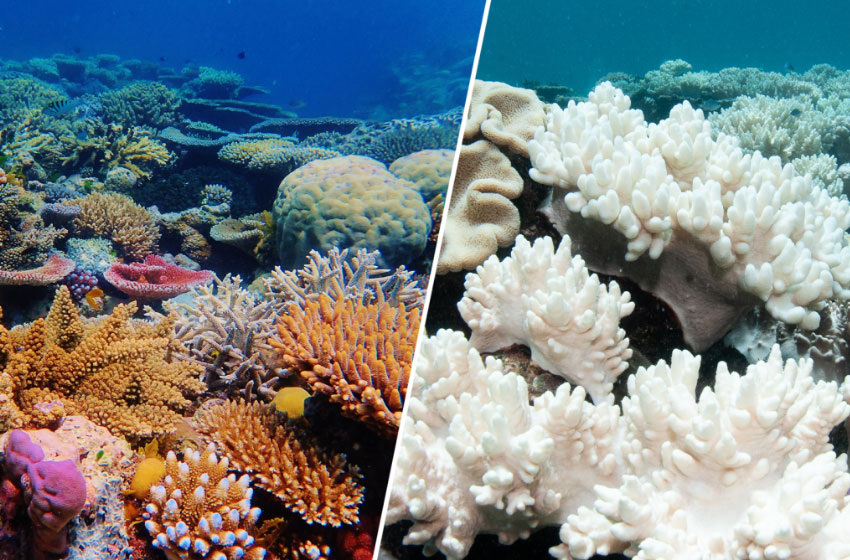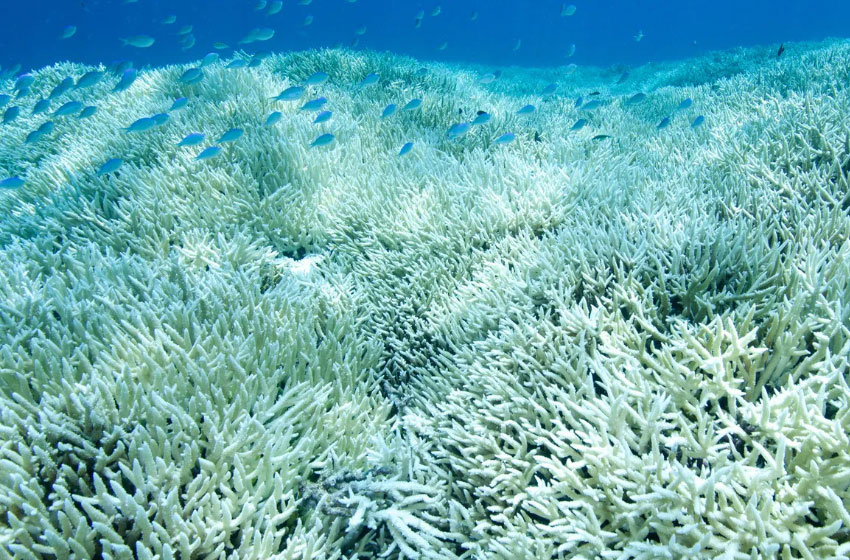Unprecedented Coral Bleaching Strikes the Great Barrier Reef Again

The Great Barrier Reef, one of the natural wonders of the world, is currently undergoing one of the most severe coral bleaching events on record. This distressing phenomenon, marking the second major bleaching event in the past decade, echoes a troubling pattern of environmental challenges facing coral reefs globally. According to the US National Oceanic and Atmospheric Administration (NOAA), these incidents are becoming more frequent and intense, signalling a dire need for immediate and effective conservation strategies.
Understanding Coral Bleaching
Coral bleaching occurs when coral polyps, the living organisms that make up the coral, expel the algae (zooxanthellae) that live in their tissues. Normally, these algae provide the coral with up to 90% of their energy through photosynthesis and give them their vibrant colour. However, when corals are stressed by changes in conditions such as temperature, light, or nutrients, they release these algae, leading to a white, ‘bleached’ appearance. While bleached coral is not dead, it is under significant stress and is more susceptible to disease and death.
The Severity of the Current Bleaching Event
The current bleaching event affecting the Great Barrier Reef is particularly alarming due to its widespread impact. Researchers monitoring the reef have reported extensive bleaching across large areas of the coral network, from shallow inshore areas to deeper and more remote sections. The intensity of this bleaching event surpasses previous occurrences, affecting even the most resilient coral species and those previously spared from severe impacts.
Causes and Contributing Factors
The primary driver of the recent coral bleaching events is the unusually warm sea temperatures resulting from climate change. The increasing concentration of greenhouse gases in the atmosphere has led to a rise in global sea emperatures, which exacerbates the natural phenomenon of El Niño and its effect on marine temperature stability. Additionally, pollution, overfishing, and runoff from agriculture contribute to the stresses on coral ecosystems, compounding their vulnerability to thermal changes.
Global Context and Repercussions
The situation at the Great Barrier Reef is not isolated. Coral reefs around the world are experiencing similar fates due to rising sea temperatures and environmental degradation. These ecosystems are crucial for marine life, providing habitat, food, and breeding grounds for numerous marine species. The decline in coral health has dire implications for biodiversity, fisheries, and the global economy, particularly for communities that rely on coral reefs for tourism and fishing.
Research and Monitoring Efforts
Scientists and researchers are intensively monitoring the Great Barrier Reef, employing aerial surveys, satellite technology, and underwater observations to assess the scale and impact of the bleaching. This data is vital for developing strategies to manage and potentially restore affected coral systems. Australian research institutions, along with international bodies like NOAA, are at the forefront of studying the links between coral bleaching and environmental factors, aiming to predict and mitigate future events.
Conservation and Mitigation Strategies
In response to the bleaching events, several conservation strategies have been proposed and implemented. These include efforts to reduce local stressors, such as improving water quality through regulations on runoff and reducing direct human impacts from tourism. Additionally, there is a significant push towards global climate action, as reducing greenhouse gas emissions is critical to controlling sea temperature rises.
Innovations in Coral Science
Advancements in coral science, such as selective breeding for more resilient coral species and developing artificial structures to promote coral attachment and growth, offer some hope for the future of coral reefs. Researchers are also exploring the potential of coral “probiotics,” introducing beneficial bacteria to help corals cope with stress and combat disease.

The Role of Public Awareness and Policy
Public awareness and policy play pivotal roles in addressing the challenges facing the Great Barrier Reef and other coral systems. Advocacy and educational campaigns are crucial in driving policy change and motivating individual action on climate change and environmental grounds for numerous marine species. The decline in coral health has dire implications for biodiversity, fisheries, and the global economy, particularly for communities that rely on coral reefs for tourism and fishing.
Research and Monitoring Efforts
Scientists and researchers are intensively monitoring the Great Barrier Reef, employing aerial surveys, satellite technology, and underwater observations to assess the scale and impact of the bleaching. This data is vital for developing strategies to manage and potentially restore affected coral systems. Australian research institutions, along with international bodies like NOAA, are at the forefront of studying the links between coral bleaching and environmental factors, aiming to predict and mitigate future events.
Conservation and Mitigation Strategies
In response to the bleaching events, several conservation strategies have been proposed and implemented. These include efforts to reduce local stressors, such as improving water quality through regulations on runoff and reducing direct human impacts from tourism. Additionally, there is a significant push towards global climate action, as reducing greenhouse gas emissions is critical to controlling sea temperature rises.
Innovations in Coral Science
Advancements in coral science, such as protection. Policies that address both the symptoms and the root causes of coral bleaching are needed to provide comprehensive solutions.The plight of the Great Barrier Reef serves as a stark reminder of the broader environmental crises facing the planet. The escalating frequency and severity of coral bleaching demand an urgent and concerted response from global leaders, scientists, and communities worldwide. As the guardians
of these natural treasures, it is imperative to implement robust measures to safeguard and preserve them for future generations.
The current crisis facing the Great Barrier Reef is not just an ecological catastrophe but also a clarion call for sustained and effective environmental stewardship.







